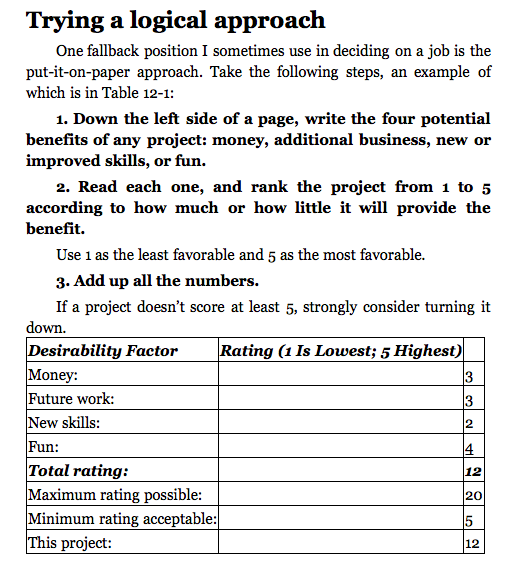PART 1 – Killin’ It Already: Getting Set Up For An Epic Win
3 Chapter 3: Securing a Client
Finding a client can be just as awkward, if not more. It’s akin to being on a first date, you’re trying to impress, maybe they’re trying too or looking to see what you have to offer first. Being proactive means you’ve already started putting feelers out there to see where there might be potential client connections.
Surely you’re ready to skip this chapter altogether, but not so fast. There are a few key things you’ll need to know before signing on the dotted line with a company. Like a date chaperone, we’re here to keep you going in the right direction, so stay for the ride.

Where to Look
The simplest first step is to start with who you already know. As Freelancing for Dummies explains, “Where miners find one diamond, they know they’re likely to find others. The same is true of clients [or employers]. It’s a lot easier to keep digging in the same spot than to blast out a whole new mine.”[1] Hopefully you’ve kept in touch with past managers, if not, it’s a good practice to start now. Literally, right now.
Hmm, we haven’t been in touch. How do I initiate a contact?
Send them a thoughtfully handwritten note of gratitude, explaining what you most appreciated about working with them, how they helped you in a specific way, or what you gained from being part of that company. A birthday or greeting card for a silly holiday will work just the same. Or a simple email following up on something personal that you remember, such as, “Where is your son headed off to now that he’s graduated?” or “How was that xyz concert you attended? I heard there was a really good turnout.”
No matter what you send, ensure that you also include a statement explaining that they’ve been on your mind and you’re hoping to work with them in a different capacity. Don’t forget to include a call to action like, “Perhaps we can have lunch next week to chat about a new project I’m gearing up for. Send me an email to let me know if you’ll be free.”
Now that your arts and crafts are done and the letters have been sent out, do not sit and wait. It’s time to keep your strategy game strong, and look out for other opportunities.
Connect with friends, family, current and former coworkers to ask for a referral.
Gently encourage them to put in a good word for you at their company or within their networks. Be sensitive though, not everyone feels comfortable putting in a referral, so let the person you’re asking know why/how you’ll benefit and reassure them that if they don’t feel comfortable doing it, it’s okay too.
If you have a particular company in mind and have a connection there, start by making a specific request, “I have an exciting new project that I’m hoping to collaborate with YYY company on. [Insert brief project description]. Do you have any contacts there that you think would be interested in exploring this with me?”. If you don’t get much traction, don’t be afraid to ask the person if they know of anyone/any other company that would be suitable to connect with. If you end up getting referred, it’s super important to send a formal, personal note of thanks right away. That person, after all, has taken the time and effort to make a connection for you and has put their reputation on the line.
Finding a client is a time-consuming process. And sometimes the clients you have contacted have a few concerns, but are reluctant to tell you for various reasons. Their responses to your request are often vague and uncertain, which give you a glimmer of what you think is hope. Don’t be tricked. You need to actively look for a client from as many possible sources as possible. Additional sources you could try are:
- Connect with alumni
- Cold calling. Yes, this one is challenging, but still worth a try.
- Take up any opportunity to meet people. Attend networking events, workshops, corporate functions, etc.
- Use social media to put out feelers in your networks
- Research the client profiles supplied by the department. Contact them at trsitm@ryerson.ca
- When in meetings with any professionals, strike up casual conversations with those at the table to find out more about what they do
What to Look For
As far as client requirements go, the client you choose will need to meet the below criteria. You can and should use these as a first stop to help you sort out the weeds from the actual prospects.
- Has its headquarters located in Canada
- Has an active interest in the project
- Has capacity and willingness to work with your team actively for 8 months
- Is willing to share confidential information with you
- Can and will give you access to the right people
- Is open to using information technology to improve its operations
Once you’ve found companies to connect with, there are many things to consider when engaging in initial discussions with them. Your project has to be process oriented, with goal(s) that involve multiple tasks and stakeholders. The end result of your team’s work will involve a complete IT solution (ex- enhancement of existing features, data migration, website design/enhancement, improving the speed of a network, etc.). See here for examples of 2 past projects. Also, be sure to check the Capstone website periodically to see a list of clients previous teams have studied.
The process itself doesn’t need to be IT related (can be a business process), there just needs to be the opportunity to equip your client with the right tools/technology that’ll help them continuously and systematically perform better.
As well, you’ll need to carefully gauge the following when interacting with potential leads:
- Type of project
- Scope of the project
- Level of support being offered
- Ex- sponsor, response times, contact person, and frequency of communication
- Client size
For those of you thinking that it’ll be easy peasy running with a Mom and Pop shop or a better opportunity flying with a large corporation, you should at least know what you might be up against in both cases (see below) . One isn’t necessarily better than the other, it just simply boils down to team preference and the project opportunity offered.
| Large Companies | Small Companies | |
| Pros |
|
|
| Cons |
|
|
So, you might be wondering what the right client ‘looks’ like after all. The following table should hopefully help you know what to expect and what to look for.
| The Ideal Client … | Though, more often than not … |
|
|
Pitching to Prospects
Even if you’ve found an ideal client, it won’t necessarily be a love match right away. Oftentimes, clients need some ‘romancing’. They won’t always see the Capstone project as a mutually beneficial opportunity, so you’ll need to do a little work to sell your skills with charisma (unlike a greasy used car sales person).

Of course, before you’re off showing people the sparkliest side of you, you’ll need to have a good handle on what the project is all about. There’s no sense trying to schmooze with a client if you’re even unsure of the details and goals. Why not take your knowledge for a spin?
Feeling ready to pitch this bad boy to potential clients? Great! You can deliver your pitch in one of two ways. Which option is suitable for you?
Regardless of which option you pursue, your team will need to do significant prep to learn about the company, the people who will be receiving your pitch (do a little LinkedIn stalking), the potential business problems the client may have, and how your Capstone project can respond to that problem. Knowing these details will put your time in a prime position to win that ‘business’.
Speaking of winning the business, you’d be remiss to step away from a pitch without actually asking for the business. You could have just delivered a glorious pitch and without a call to action, there’s no encouragement for … well … action. You’ll need to actually say the words, “We would like to work with you on this project.”
You may be ready to sell this project like nobody’s business, but are still fretting over the proposal itself. Unsure of where to start or what it should look like? In The Best of Smashing Magazine, professional Web Designer and author, Cameron Chapman, explains, “Exactly how you format your proposal is up to you, but there are certain parts that virtually every proposal should include. Feel free to get creative in the design of the proposal, but remember that the primary purpose is to convey information. Anything that interferes with the readability of the document should be cut.”[2] For additional resources on pitching and proposals, check out Part 5.
Sizing up a Project
You’ve finally found a client, yay! You’re thinking, “Yes, I can graduate now!” and they’re thinking, “Whoop! Free consulting services, holla!”. Both parties are ready to sign the contract, or in some very adventurous cases, just dive right in, but hold the phone. Has your team actually assessed the project you’ll be jumping into? Knowing what you’re getting into and what you’ll be up against is extremely important. Remember, you’re supposed to be setting yourself up for success, not a game of Russian Roulette.
The hope is that across several clients, you’ll be presented with a few project opportunities to choose from. The projects presented to you can bring an array of benefits including a possible future business/work opportunity, an opportunity to put your knowledge and expertise into practice in a real context, a chance to learn new or improve current skills, and a fun/enjoyable work experience. Not every project that comes your way will carry all of these benefits, but if any one of them does, you probably have a winner. For the rest that won’t help you achieve all of these benefits, you’ll need to decide whether or not it’s still worth it to pursue the opportunity. There may be other factors that still make it worth your while. Have a go with the Dummies method[3] of rating a project to help guide your decision. You will, of course, need to modify the table to include the criteria that are most important to you (hint: money shouldn’t be a factor).
ACTIVITY

Items that scored a 4 or 5 are noteworthy things that deserve attention. If anything was rated a 2 or below, it’s an indication that the project will be quite unfavourable in that area. While the minimum acceptable rating should be 80% of the maximum possible score, it’ll be important to check that the pros of pursuing the project outweigh the cons. Using the concepts discussed in this article, get your team together to hash out on paper every possible perceived positive and negative of taking on the project. Is one side literally heavier than the other? This is something to think about.
As a final stop, do a ‘gut check’. Imagine that your team has accepted the project and it’s now one month into the school term. What are the possible results of your decision? How do you feel about that? Now, imagine that your team rejected the project and ask yourself the same questions. Do you sense any relief or regret? These could be good indicators of your true thoughts. If you have any doubts at all, it’s always a good idea to check with the course coordinator.
Pitfalls to Avoid
During initial interactions with clients, don’t meander through conversations without paying attention to what you’re hearing, what you’re observing, and the implications both can have on your team. You should have your Elmo eyes on, looking out for any warning signs that indicate ‘Danger Ahead’. Some red flags that should get you thinking twice are:
- Aggressive and negative attitudes
- The client speaks negatively about other Capstone groups they’re interviewing, employees they have, or other companies
- You’re constantly pushed to prove your value
- Treat themselves as Gods, and expect you to make them happy at all times
- Unrealistic expectations
- Overloading you with data without taking the time to explain things to you and give you context
- Recklessly throwing in extra tasks (scope creep) without consideration for time, skill, and capacity constraints
- Lack of appreciation of the academic course requirements
- Not flexible. Client is insistent on a particular solution/software/approach in the project
- Lack of collegial and cooperative working culture
- Unclear understanding of issues at hand
- Little or no budget for implementation
- Chaotic and disorganized
- Client asks you to develop an overly comprehensive proposal without any guidance
- Not flexible. Insistent on a particular solution/software/approach before you can even perform any analyses
- Client who change their mind quickly, without communicating changes or understanding the implications changes can have
- Talks of restructuring or role changes are on the horizon
- No thoughts or cares about a plan to move forward after your project is done (who runs with your project once you’ve completed requirements? Implementation? Maintenance?)

Saying ‘No’
You’re considering dropping the ‘n’ word. No need to get into a panic. If your team is considering rejecting a project, by this point you all will have put considerable thought into opportunity, including doing the previous assessments and asking advice from others outside your situation (ex- professor, friends, professional in the field, alum, etc.). Whichever reasons caused you to arrive at this thought, you want to give yourself time to evaluate your thoughts.
Often students feel the pressure to respond right away. Only benefit can be had by telling the client that you and your team will need some time to discuss and review the offer. It won’t make you look bad, in fact, it shows wisdom in wanting to take time to reflect, observe, and come to an un-rushed conclusion. But be sure to let the client know when they can expect to hear back from you, otherwise, you may just lose the opportunity.
If saying ‘no’ feels right to your team after all, you can let the client know in person, by email, or by phone (not in a voice message) as long as you cover:
- A statement expressing how grateful you all are for the time they’ve spent exploring the opportunity with you
- Why you’re rejecting the offer (ex-project/company isn’t a good fit, received a more suitable offer, team doesn’t have the right skill set, etc.)
- If you know of another team that might benefit from the opportunity, refer them
- Wish them the best in finding a student group match
- Leave contact details in case they have any further questions
Saying ‘Yes’
Found the right fit for you? Congratulations! This is a big deal *insert victory dance*. Let your client know in writing that your team has accepted the offer and follow the action items outlined in Part 3.

- Drake, S. M., Recorded Books, & LLC. (2013). Finding Clients. In Freelancing for Dummies(p. 142). Hoboken, NJ: John Wiley & Sons. ↵
- Smashing, M. (2012). Pitching Like a Pro. In Successful Freelancing for Web Designers (p. 48). Smashing Magazine. ↵
- Drake, S. M., Recorded Books, & LLC. (2013). Evaluating Jobs and Projects. In Freelancing for dummies (pp. 186-187). Hoboken, NJ: John Wiley & Sons. ↵


Feedback/Errata